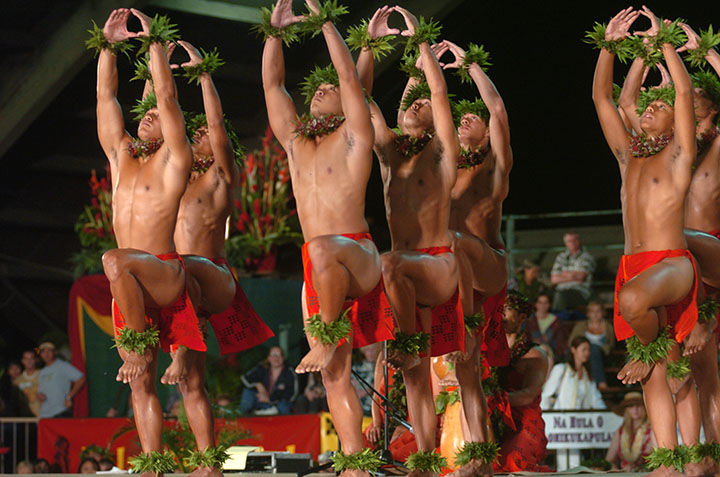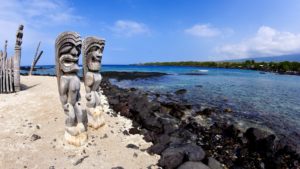
Ka Leo O Laka I Ka Hikina O Ka La is the name of this Merrie Monarch champion men’s hula group. They are led by kumu hula (hula master) Kaleo Trinidad. Photo: Dennis Oda/Honolulu Star-Advertiser.
Aloha kākou! As the world waits in anticipation of the 2017 Merrie Monarch Festival, we present to you ʻike, or wisdom, from the judges who are responsible for scoring the three days of hula competition. What are they looking for? What are the values of hula? Learn about the Miss Aloha Hula competition and the responsibilities of the contestants. Learn the manaʻo, or thought process, behind adhering to traditional ways and the importance of hula lineage. And finally, prepare yourself for the exhilaration of hula ʻauana.
Miss Aloha Hula
It’s difficult to convey in words how much kūleana, privilege and responsibility, the Miss Aloha Hula contestants carry with them. Haumana means student, in this case hula student.
When she graces the stage, the Miss Aloha Hula contestant represents her family, both past and present, her kumu hula (hula teacher) and her hula lineage. As carriers of the Hawaiian culture, each dancer is held to the highest of standards.
Traditional Hula, Hula Kahiko
“They [traditions] come from our kūpuna,” says Holoua Stender. Kūpuna means ancestors. Hawaiians cherished knowledge and wisdom passed down from those who came before. Kumu hula, hula teachers, pass down their knowledge and traditions to their students who will in turn pass down the knowledge to their own students. This is why lineage is so important; it is where wisdom and credibility come from.
The word kāholo refers to a basic four step dance movement. The word ʻuwehe refers to a basic step and pushing out of the knees. These steps are basic and universal across hālau, hula groups, that Etua Lopes references. Hālau, however, have slightly different ways of performing these same basic movements. The styles become signature of the varying hula lineages. Each hālau preserves the tradition of their own lineage; otherwise, the knowledge and wisdom become lost.
The Friday night Hula Kahiko competition is a showcasing of ancient knowledge and wisdom passed down through generations.
The Heartbeat of the Hawaiian People
This video is a must-share, because it gets to the heart of hula. As King David Kalākaua once said, “Hula is the language of the art, and therefore the heartbeat of the Hawaiian people.” This video demonstrates that the heartbeat of the Hawaiian people is strong and humble.
This video also demonstrates the value of lineage among kumu hula and their haumāna (students).
Modern Hula, Hula Auana
Smiles and pageantry; be prepared to be charmed beyond imagine. While hula kahiko is all about tradition, hula ʻauana is all about capturing the audience’s (and judges’) hearts. The final night, Saturday night, concludes with the awards ceremony that runs late into the night. Once the last trophy has been awarded, watch for impromptu dancing by the kumu hula themselves. This is when the legends and masters may take to the stage for some “good fun” showcasing the joy and camaraderie of hula.
If you’d like to see the performance by Chinky Mahoe incorporating American sports into hula referenced by Holoua Stender, you can click here. Be forewarned, however, the video is of 1994 quality.
That being said, we hope this leaves you with a greater understanding of the art of hula and its significance to the Hawaiian people as well as a more meaningful Merrie Monarch experience. Aloooha!
2017 Judges
Ainsley Halemanu, Rachel Lahela Ka‘aihue, Pualani Kanaka‘ole Kanahele, Etua Lopes, Pi‘ilani Lua, Keali‘i Reichel, Kalena Silva
Live Streaming
Remember! The Merrie Monarch is streamed live online at www.merriemonarch.com/live-streaming as well as broadcasted live on KFVE-TV.
For more information about the Merrie Monarch Festival, visit www.hawaii.com/tag/merrie-monarch-festival/.







